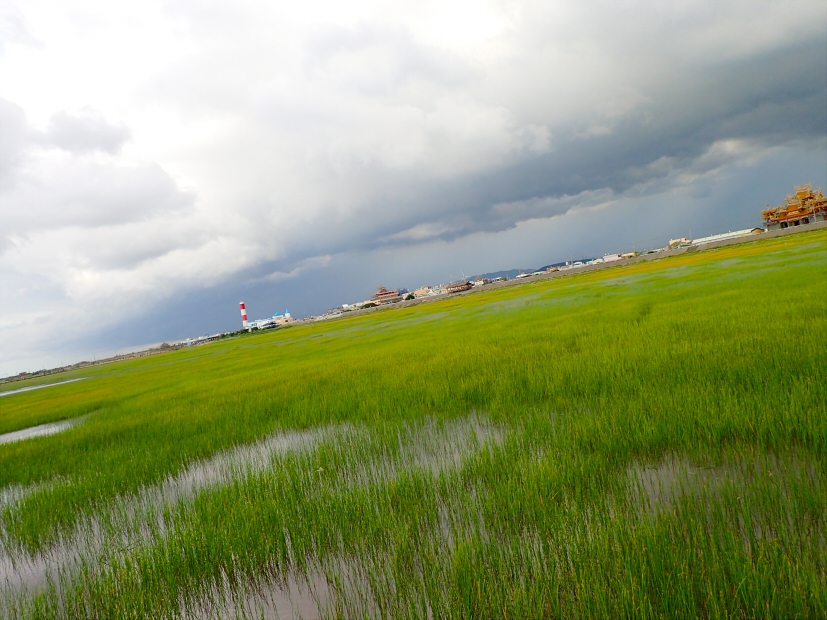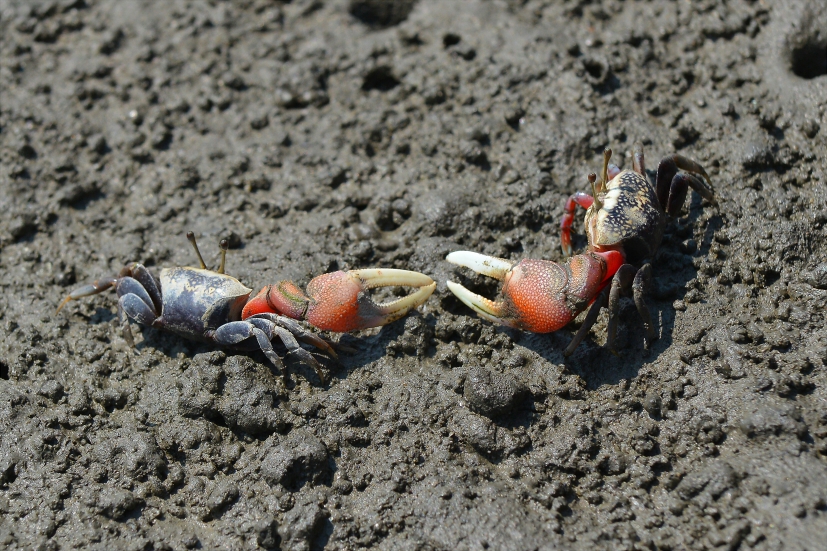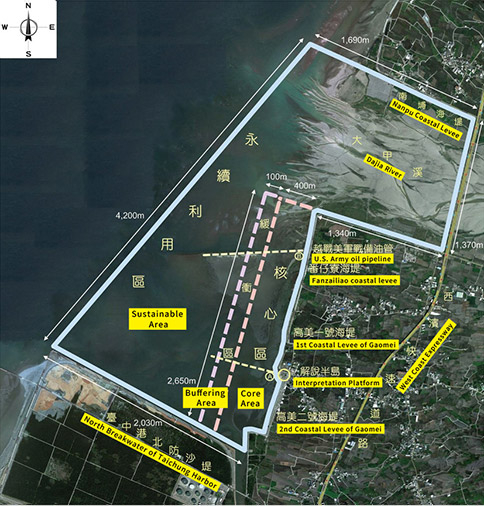
The well-known Gaomei Wetlands, despite being surrounded by beautiful views and wildlife, are in the shadow of ecological crises. These crises include: the declining growing area of the Yunlin sedge, terrestrialization of the wetlands, invasion of the introduced smooth cordgrass, and crabs killed by motor vehicles.
Originally adjacent to the Gaomei I and Fanziliao Levees, the growing areas of the Yunlin sedge have been receding away from the levees since 1997. These two growing areas have been affected by competition with the smooth cordgrass and wetland terrestrialization since 2007, gradually causing relocation towards the west and northern Dajia River. Yunlin sedge growing outside the Gaomei II Levee has moved towards the west and southern Qingshui Drainage area because of wetland terrestrialization. However, competition with the Kandelia candle has limited the Yunlin Sedge from forming a stable population there. Overall, the Yunlin Sedge in Gaomei Wetlands is facing reduction of its growing areas.
The smooth cordgrass, like the Yunlin sedge, is a coastal plant and is, currently, an invasive species recognized by countries around the world. Its population spreads rapidly by growing lateral buds from the plants’ rhizomes, which restricts the growing areas of the Yunlin sedge and common reed. In addition, its complex underground root system hardens the beach soil. Wetland terrestrialization decreases biodiversity and smooth cordgrass is one of the main factors accelerating terrestrialization. The invasion of smooth cordgrass changes the composition of benthic organisms and biodiversity on the beach, as well as the population structure of waterbirds. Many countries devote large amounts of money on large-scale projects to remove cordgrasses, but are not very effective. The optimal time to eliminate smooth cordgrass is during the early stages of invasion when spreading has not yet occured and should be entirely removed. Since smooth cordgrass invaded Gaomei Wetlands in 2007, it has spread rapidly. In 2016, its growing area first exceeded 3 hectares. From the perspective of wildlife refuge operation and management, this has posed a threat to the local wetland ecosystem and biodiversity. The government has scheduled to remove the smooth cordgrass and hopes to ensure the biodiversity and ecological integrity in the preservation area as much as possible under the objectives and scope of wildlife refuge operation and management.
Many tourists visit Gaomei Wetlands in the summer, and most of them leave in the evening. This happens to be the time when terrestrial crabs leave their burrows and head to the beach to release their eggs. A large number of crabs are killed as a result along the flood-control roads around the wetland. The transport network around Gaomei Wetlands and the levee foot design prevent the crabs from crossing into the beach. They are instead trapped on the road, crushed by cars, and even killed by ants. Local terrestrial crabs release their eggs mainly during summer’s spring tides, which happen within three days after the new and full moons of the lunar calendar. Roadkill hotspots are mainly on the north side of Gaomei Wetlands by the Fanziliao Levee, with an average of 50% of females being killed by motor vehicles or ants every night. The average body size of these females is half the size of normal mature individuals, meaning that the local crab population is facing great reproductive pressure. The females reach maturity and release their eggs while they are still small in order to still produce offspring. Anthropogenic factors are the clear causes behind these deaths and early maturity. Therefore, the transport networks and levee foot design both require re-evaluation and planning for a more eco-friendly design in order to meet the ideal setup for the wildlife refuge.

To preserve the local wetland ecosystem, the Council of Agriculture approved and announced Gaomei Wetlands as the “Gaomei Wetland Preservation Area” on September 29th, 2004. The purpose of a wildlife preservation area is to protect local wildlife and their habitats. Based on the Wildlife Conservation Act, the government announces these key areas as wildlife refuges or major wildlife habitats. Inside a refuge, killing wildlife and collecting or cutting plants is prohibited. Lands, if necessary, can be expropriated or appropriated and taken into the authorities’ administration according to the law. On December 19th, 2007, the Construction and Planning Agency of the Ministry of the Interior classified Gaomei Wetlands as a national class wetland. The Taichung City Government further announced and implemented area control for Gaomei Wetlands, in which the wetland was divided into three areas: the core area, the buffering area, and the sustainable area. Tourists are not allowed to enter the core area and the buffering area. Research or investigation units are allowed in these areas after approval of their applications. Trespassers in the restricted areas could be fined NT$ 50,000-250,000 according to regulations.
▶ The regulations and areas of Gaomei Wetland Preservation Area announcement (Mandarin Version)
▶ Wildlife Conservation Act


